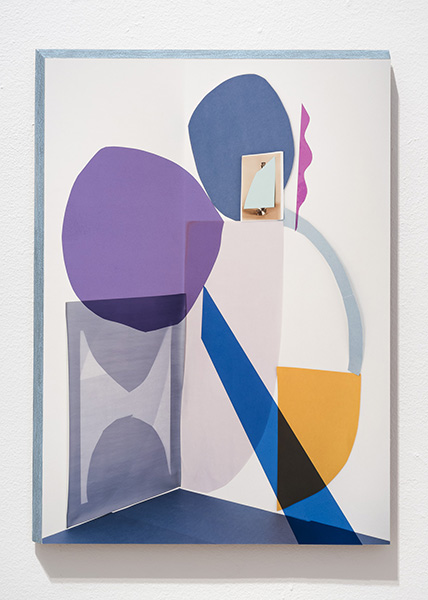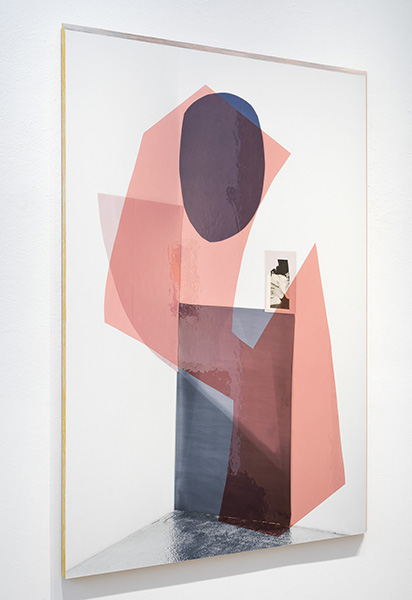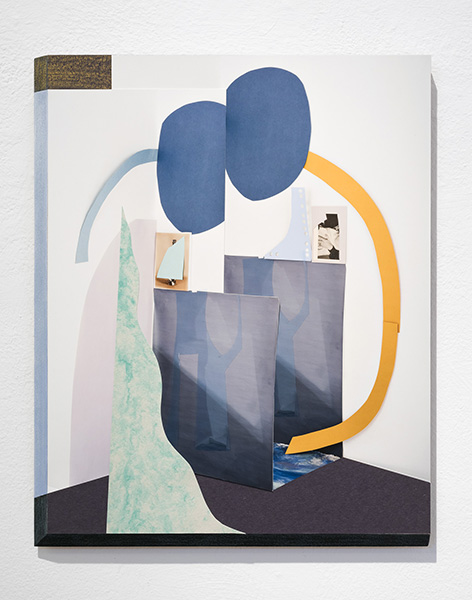
July 23, 2018
Phillip Maisel @ Gregory Lind
by Maria Porges
Recently, I heard someone say that she had seen a show—meaning, she’d scrolled through images on her computer. In As it Lays, Phillip Maisel puts paid to the idea that such a thing is even possible by constructing a body of work that simply cannot be fully understood in reproduction: demanding, as it were, a face-to-face experience. Though one can say this is required for all art, in this case, this assertion is more than a fatuous truism. Maisel’s kryptonite for the presumed power of the screen to reveal all comes in the form of photographic images of collage elements arranged into still lifes in shallow space, onto which additional collaged elements are added — creating a diabolical shift from three to two dimensions and back again. The experience of being in the same room with these works is enjoyable but vaguely unsettling. It is simply not possible to tell what is an actual piece of material — cut paper or transparent gel— placed on the surface of an image, and what is an image ofthe cut shape, photographed in a studio set-up, to cast slender shadows that cunningly deceive. Consequently, the only way to distinguish between pictures of objects and actual objects is to peer at the surface, sliding your eyes across it with the kind of anxious attention usually reserved for checking one’s own appearance in a mirror.
Recently, there has been a widespread renewed interest in photo collage, the roots of which reach back to Dada and Surrealism. Maisel’s work is a little different from much of the field, though. Since graduate school, his experiments with taking pictures of arrangements of various materials have evolved, each body of work focusing on a different cast of “characters” and set of parameters. Among these variants is palette; his use of color in each body of work is distinctive, almost to the point of being idiosyncratic. Then there are presentation strategies, ranging from unusual alignments to unexpected locations of finished works on the wall. He is also clearly preoccupied with the thing-ness of the final product. Moving away from conventional framing, he has mounted the pigment prints in this show onto rectangular slabs of panel, cutting one or more edges at a steep angle. These edges are fully visible when the image is seen from the front — an experience he emphasizes by coloring them with wax pastel in hues that complement those that appear in the compositions. This encourages a peripatetic viewing experience, walking from side to side, watching the colored boundaries appear and disappear. In Sleeping Hands 3062, for instance, the right angle formed by the bright yellow top and right edge that “frames” the violet blues in the picture shifts in and out of sight depending on the angle of your approach.
Like the painter Giorgio Morandi, Maisel uses some of the same still life elements over and over—a practice that is especially evident in this show, where, for example, a large blue blob-shaped paper cutout appears in all but one piece. Unlike Morandi, though, Maisel often turns or flips his repeated elements, transforming their irregular shapes in to something new by making us see them differently. Mirrors or reflective surfaces have been a leitmotif in previous bodies of work, doubling and reversing parts of a set-up; here they show up at the bottom of several works as a triangle of mysterious shiny silver, possibly foil-covered insulation board.
A couple of found photographs also make an appearance. What they depict seems less important than the fact that they arepictures, possibly a kind of mordant joke about photography itself. In several pictures, most of the contents of those photo-graphs are hidden with irregular scraps of blue. Another piece contains an image of a mother holding a sleeping baby; that image provides the name for the series, though “sleeping hands” is apparently also a symptom of carpal tunnel syndrome, a reference that Maisel finds intriguing as well.
Layering has always been central to Maisel’s approach. Exploiting transparence or translucence, he hides and reveals, overlapping all or part of one color/shape with another, as in Sleeping Hands (2994). Two pinkish elements—one opaque, the other translucent—echo the forms of the composition onto which they have been collaged, alternately denying the space they inhabit and floating within it.
After early experiments a decade ago with stacked images of landscapes and famous people downloaded from the internet, Maisel began photographing arrangements of layered scrap materials piled against a wall, always shooting from an angle to reveal the accumulation of edges and shadows. Gradually he refined this approach, moving towards a trompe-l’oeil subtlety that toggles back and forth between flatness and space, the thing and the image of the thing: one of the central preoccupations of modernism. It’s not an accident that there are echoes of Matisse’s cutouts, or Calder’s turning forms, in works like Sleeping Hands (3042).
“As it lays” refers to the practice in golf of playing a ball, no matter how unfortunate its location. More generally, it means dealing squarely with adversity For Maisel, it has to do with the actions that lead up to the final work, each built on what came before: arranging materials, photographing them, and using small contact sheet images to plan collages; then making the collages at full scale, sometimes using elements left over from earlier works — a method that explains the awkward shape of some elements, but not the seemingly perfect way the artist pieces them together.



